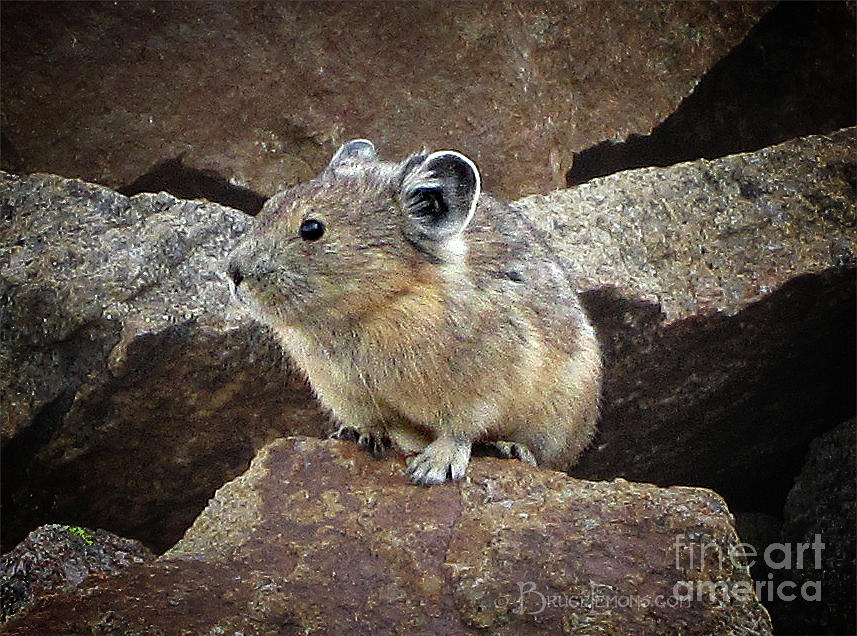
 Food gathered throughout the summer and “haystacks” built and defended for winter food. After one month, the babies leave their mothers to establish their own dens, even though they don’t fully mature for another few months. Females may have two litters a year and raise their young alone. Gestation period is 30 days and litters of two to six hairless, blind infants are born. Breeding season is in late May or early June while snow is still on the ground. A high-pitched "eek" warns other pikas of predators. Vocal animals that use both calls and songs to communicate and protect their territories. They dart through rocky areas and tunnels under snow. Active year around-they do not hibernate. Excellent hearing and vision to warn them of danger in their surroundings. Sharp curved claws and padded toes allow them to scamper around alpine rocks. Short tail that is not externally visible on most individuals. Oval bodies that are only around 6 – 7 inches long and weigh just over six ounces. Small mammals related to the rabbit family, even though they look more like a hamster or a guinea pig. See detailed map in Hafner and Sullivan (1995).Pikas are busy farmers as they collect and harvest their winter food cache. Near the lower elevational limit, individuals may be inactive at midday in hot weather (Smith and Weston 1990).ĭistributed discontinuously in mountainous areas in western North America, from central British Columbia and southern Alberta south to east-central California, Nevada, southern Utah, and northern New Mexico east to Wyoming and Colorado ranges from sea level to 3000 m in north, uncommon below 2500 m at southern range limit (Smith and Weston 1990 Hoffmann, in Wilson and Reeder 1993). Pikas are active diurnally throughout the year. Pikas regularly ingest caecal pellets, either directly or after storage. In winter, some foraging may occur in snow tunnels. In late summer and fall, pikas harvest and stores food (forbs, grasses, marmot pellets) for winter consumption stored food may be most important when winter is unusually harsh or long (see Smith and Weston 1990).
Food gathered throughout the summer and “haystacks” built and defended for winter food. After one month, the babies leave their mothers to establish their own dens, even though they don’t fully mature for another few months. Females may have two litters a year and raise their young alone. Gestation period is 30 days and litters of two to six hairless, blind infants are born. Breeding season is in late May or early June while snow is still on the ground. A high-pitched "eek" warns other pikas of predators. Vocal animals that use both calls and songs to communicate and protect their territories. They dart through rocky areas and tunnels under snow. Active year around-they do not hibernate. Excellent hearing and vision to warn them of danger in their surroundings. Sharp curved claws and padded toes allow them to scamper around alpine rocks. Short tail that is not externally visible on most individuals. Oval bodies that are only around 6 – 7 inches long and weigh just over six ounces. Small mammals related to the rabbit family, even though they look more like a hamster or a guinea pig. See detailed map in Hafner and Sullivan (1995).Pikas are busy farmers as they collect and harvest their winter food cache. Near the lower elevational limit, individuals may be inactive at midday in hot weather (Smith and Weston 1990).ĭistributed discontinuously in mountainous areas in western North America, from central British Columbia and southern Alberta south to east-central California, Nevada, southern Utah, and northern New Mexico east to Wyoming and Colorado ranges from sea level to 3000 m in north, uncommon below 2500 m at southern range limit (Smith and Weston 1990 Hoffmann, in Wilson and Reeder 1993). Pikas are active diurnally throughout the year. Pikas regularly ingest caecal pellets, either directly or after storage. In winter, some foraging may occur in snow tunnels. In late summer and fall, pikas harvest and stores food (forbs, grasses, marmot pellets) for winter consumption stored food may be most important when winter is unusually harsh or long (see Smith and Weston 1990). 
Nests are hidden in talus.ĭiet includes primarily grasses, sedges, and forbs, sometimes shoots of woody vegetation. Occasionally they inhabit mine tailings or even piles of lumber or scrap metal. Often they occur above treeline up to limit of vegetation but also can be found at lower elevations in rocky areas within forests or near lakes. Pikas are restricted to rocky talus slopes, primarily the talus-meadow interface. Reported home ranges: 0.3-0.5 hectares (Barash 1973) also reported as mean 0.26 hectares, range 0.04-0.30 hectares (Kawamichi 1976). Male and female territories average about the same size. Home range size is about twice as large as the defended area. Home range size varies seasonally, largest during spring breeding season. Juveniles tend to stay on natal home range or an adjacent one. Population density was 3-10 per ha in favorable habitat in Colorado in mid-August (same as in other regions) population relatively stable due to density-related social behavior (Southwick et al. Maximum lifespan is about 7 years.Īdjacent home ranges tend to be occupied by opposite sexes. Juveniles establish territories and haypiles in the summer of their birth but do not breed until their 2nd summer. Young are dependent on their mother for at least 18 days, weaned as early as 3-4 weeks. In Colorado, pikas initiate 2 litters annually but only one is weaned births occur late June-early August.

In most areas parturition begins in May with a peak in June, occurs as early as March in some low elevation areas (Smith and Weston 1990). Adult females produce 1 or 2 litters of usually 2-5 young/litter (average often 3 at high elevations), between May and September most young come from first litters. Revision of the subspecies of the American pika, Ochotona princeps (Lagomorpha: Ochotonidae). BC Conservation Data Centre: Species Summary







 0 kommentar(er)
0 kommentar(er)
